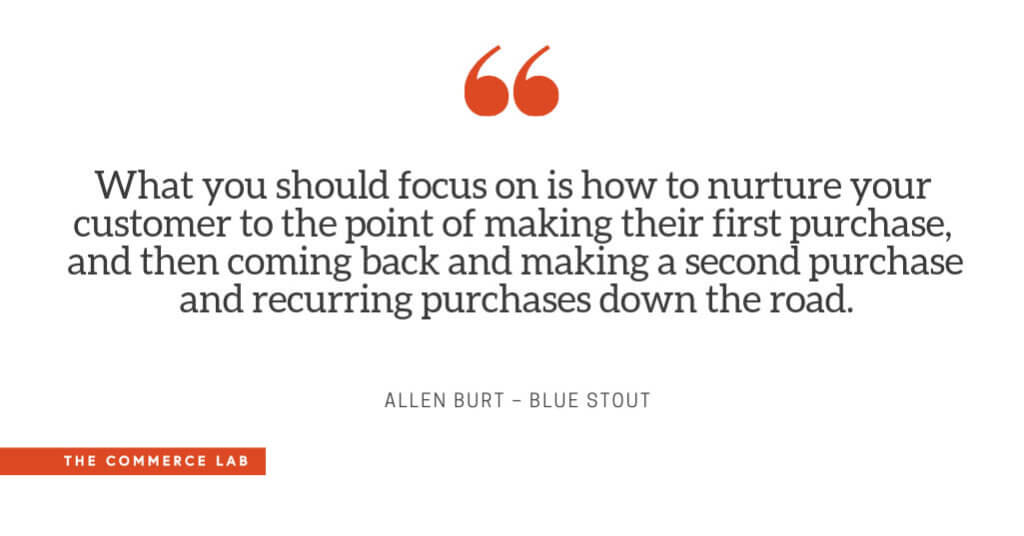Is 30% of Your Revenue Coming From Email? If Not, Then It’s Time to Ask These Questions
When clients come to me searching for ways to scale up online revenue, the first thing I always ask is this:
“Are you driving at least 30% of your online revenue from email?”
If not, there is your low-hanging fruit opportunity.
Too often, I see e-commerce entrepreneurs fail to fully utilize email marketing.
And it’s costing them LOST revenue. And a lot of it.
If you’re not at 30% yet, it’s time to start figuring out why by asking these questions:
-
- Have I set up at least 6 to 10 automated flows (each comprising of 3 to 6 emails)?
- Is my email list segmented based on customer engagement (10 to 20 segments)?
- Am I sending at least 8 manual campaigns per month?
- Are my email open rates consistently between 20 and 40%?
- Are my automated email flows bringing in 50% of the revenue from my email marketing?
Let’s look at each of these specifically:
1. Have I set up at least 6 to 10 automated flows (each comprising of 3 to 6 emails)?
So you’ve asked for email addresses from your site’s visitors and many have shared this valuable information. So what are you doing with it?
You should be creating automated email flows to set up a line of communication with your customer at each stage of their journey with you. The goal of each email is to gently push the customer one step closer to buying their first product, and then continue buying in the future.
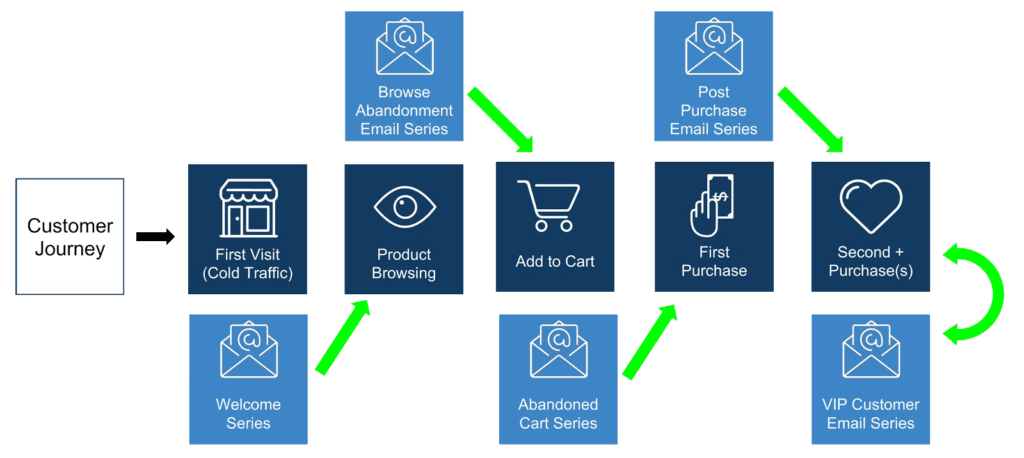
Let’s look at six critical points in your customer’s journey and what your email automations should look like:
A. When a customer visits your store for the first time
Too many store owners get this very first touch point wrong.
How?
They propose marriage on the first date.

You need to understand that it’s perfectly normal for your first-time visitor to not buy – so don’t get upset if your conversion rate for new visitors is low.
I’ve found that a potential buyer is typically going to need anywhere from 5 to 15 experiences or touch points with your brand before they are ready to open their wallet.
So your goal with new visitors isn’t to force an instant sale.
It’s building a relationship with them.
For example, you can send a series of welcoming emails that tell your story, point out how you are unique, and explain why they should trust you.

B. When the customer browses but leaves without spending (browse abandonment)
What’s holding your customer back?
That’s what you need to address in an email.
Maybe they need to see what other customers think about your brand, so spotlight some positive reviews. Maybe they need a nudge in the form of a discount or free shipping offer.
Try testing out different options to see which increases your click-through rate or conversion.
The numbers will tell you when you’ve found the right technique.

C. When the customer adds item(s) to their cart but abandons it
Abandoned carts are your enemy.
Think about it, you’ve got the customer just to the point where they are going to buy and then…..they bounce.
Fortunately, you can still reach out to them because you’ve got their email address.
Something as simple as a reminder about the item they left behind or an incentive (free gift, free shipping, discount, etc.) can bring them back to buy.
The bottom line is you don’t want to lose customers who have come this far in your sales funnel.
Be smart but aggressive here and don’t hesitate to send multiple emails or use bigger incentives (based on cart value) to reel them back in.
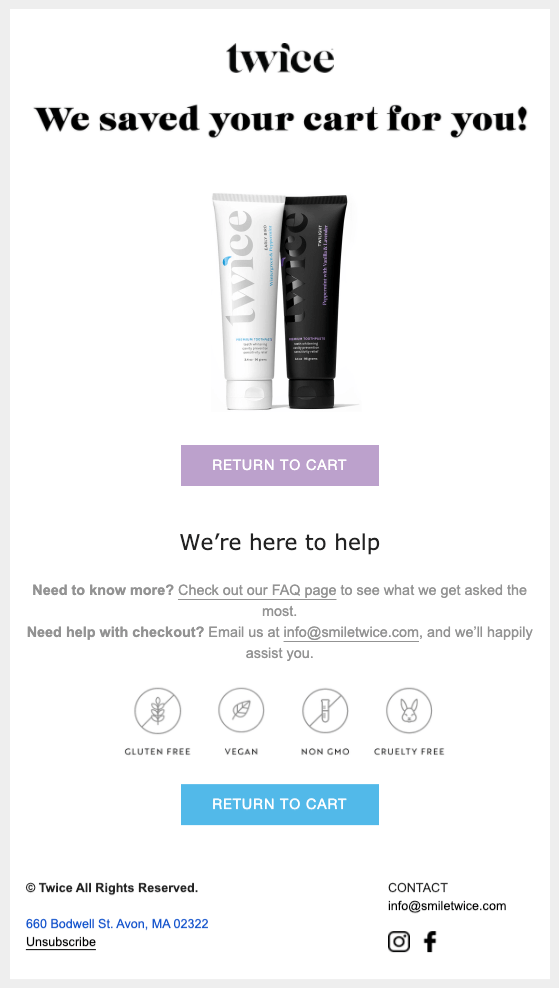
D. When the customer completes their first purchase
At Blue Stout, we always tell our clients this:
You’re not in the “making sales” business. You are in the reorder business.
And do you know when customers are most open to buying again?
Pretty much right after they just bought from you.
Yep, that’s right.
Face it, shopping gives a lot of us a good buzz. And that happy feeling will instantly make your customer feel loyal to your brand.
Your goal with email marketing is not to let that feeling pass without some speedy post-purchase emails to thank the customer and make them feel part of your brand’s community.
You can kick this messaging off right away after a purchase with the sales receipt you email.Too many businesses miss this marketing opportunity and it’s a simple way to make your customer feel valued, tell them more about your company, and cross-sell.
After that instant email receipt, make sure to send an automated flow of emails for at least two weeks after that first purchase is made so you can foster a relationship with your new customer.
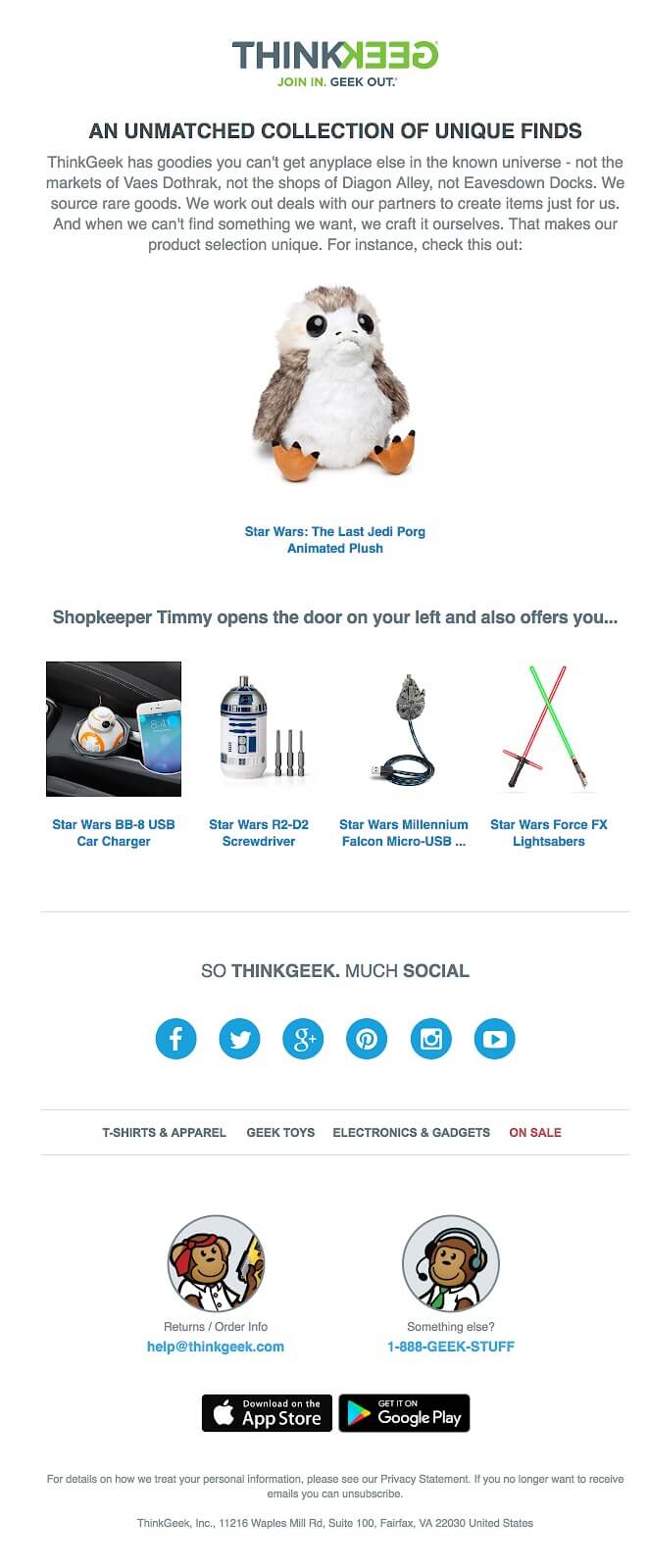

E. When the customer returns to your site again
So you’ve succeeded in convincing your customer to buy once.
How do you do it again?
It’s pretty simple.
Roll out your best offers here – think cross-selling, subscription offers for consumables, tiered discounts, or a special offer just for customers at this point in their journey with your brand.
You can do this best by sending automated email flows to customers every time they buy.
You can also segment customers further (by the type of products they buy, how much they spend, how often they shop, etc.) and send emails that are even more personalized.
Remember, targeted emails are key – you need to get the right messages to the right customers.
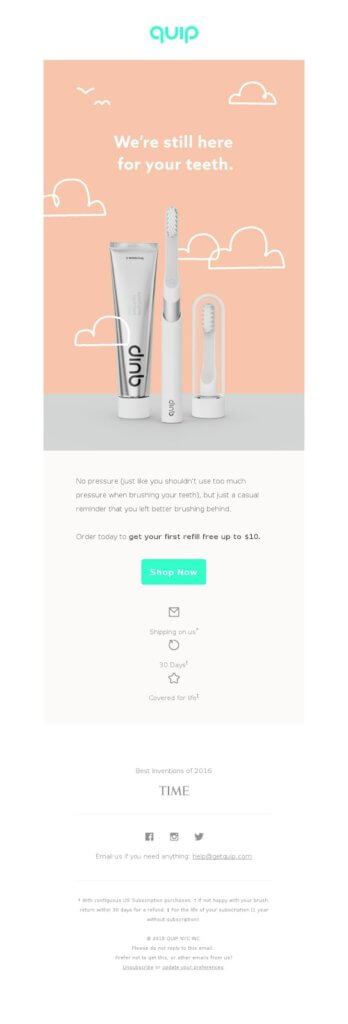
F. When customers hit “power buyer” or “mega fan” status
You love this customer — be sure to let them know.
Send emails to note milestones in their relationship with your brand, such as the first time they made a purchase.
Offer them special pricing, limited-edition merch, or first dibs on new products.
You want them to know you recognize and appreciate their loyalty.
Once you’ve created a mega fan, don’t miss the chance to let them promote you. For example:
- Ask them to review your product(s) online
- Start a loyalty/referral program to reward them for sending customers your way

2. Is my email list segmented based on customer engagement (10 to 20 segments)?
To be successful, your email strategy has to be dynamic and meet your customers where they are in their journey with your brand.
For example, you might see your customer take this journey:
-
- Visits your store for first time
- Browses products and leaves
- Visits again
- Adds items to cart but leaves again
- Returns a third time
- Buys!
- Returns four months later to place a second order
- Over the next 12 months, becomes a loyal power buyer
To get the most out of the emails you send, you need to break your customers into segments based on their engagement with your brand. Consider their recent visits to your site, clicks on emails, their interests, spending, etc.
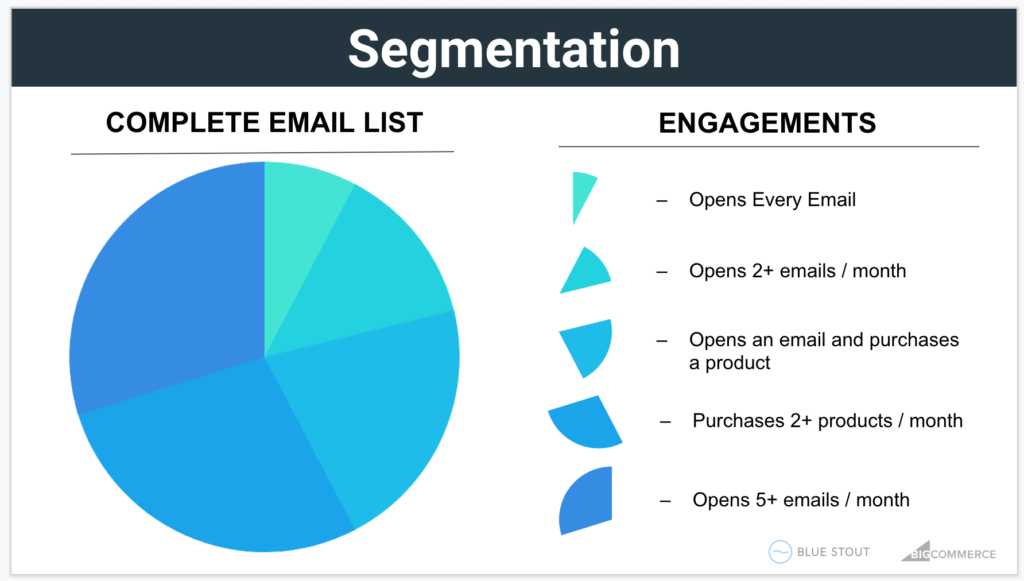
In short, creating segments ensures you get the most out of your email list. You need to understand who your audience is, how often they want to hear from you, and what content they are interested in.
For example, some customers want to receive every email you send. Others only want to hear from you once a month or less.
By sending content at the cadence a customer wants, they will be more likely to open it, engage and buy.
At the bare minimum, you should be segmenting your email list based upon engagement. For example, which people on the list have visited your site or opened an email in the past 30 days? Or who on the list has purchased once, twice, or more in the past 90 days?
3. Am I sending at least 8 manual campaigns per month?
Manual email campaigns are best for monthly newsletters and letting customers know about special events, flash sales, and new quality content.
Pretty simple, huh?
Well there’s still a lot of ways companies get it wrong.
For example, they shoot these emails out to every single person who has ever given them their email address.
For manual campaigns, you want to send a mix of sales, promotions, product launches and high-value content (recipes, etc.). At Blue Stout, we see a 50/50 mix of sales content and other high-value content as the best strategy.
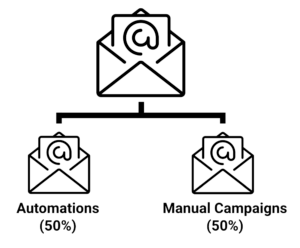
In general, eight campaigns tends to be the happy medium between sending enough email and not sending too many. But remember, this is only if you are aggressively segmenting your customer list.
4. Are your email open rates consistently between 20 and 40%?
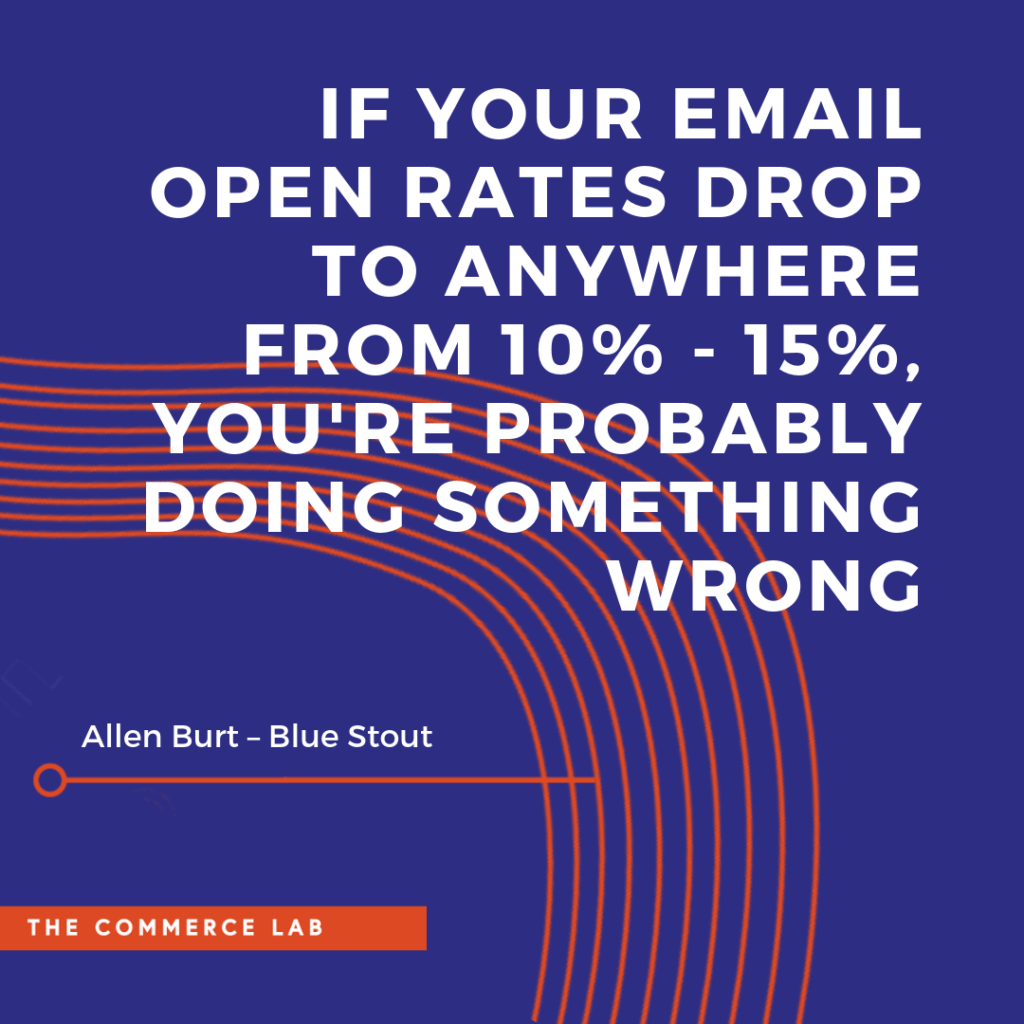
We can’t talk about this without first talking about the health of your email address list.
Email list health is the most overlooked part of most people’s marketing plan and an unhealthy list will kill even the best email marketing plan in a flash.
In fact, I’ve seen too many brands that have had their email revenue slashed in half due to poor email list management.
What goes wrong?
They send too many emails to too many customers who don’t engage, causing email open rates to drop and opening the door to Google sending future emails straight to spam.
Meaning no one sees that fabulous email offer or gets the invite to the special online event you’ve been planning for months.
Remember, as your email list grows it increase in value, but only if the emails you send end up in an inbox and get opened.
OK, now let’s talk open rates.
How many of those emails that you send get opened?
While email marketing does better in some industries than others, the average open rate overall is 20.81%. For ecommerce businesses, it’s just under 16%.
Once you factor in click rates — the average click rate is only 2.4 percent — then you have a very small window of opportunity to connect with a customer.
That’s the bad news.
The good news is even if your open rates are lagging around 10 percent right now, you might not need to overhaul your entire email strategy.
At Blue Stout, our clients see open rates ranging from 20 to 35% for manual campaigns and 30 to 40% for automated flows. Why?
Here are just a few reasons:
-
- Segmentation – Sending the right message to the right people increases open and click rates
- Solid email marketing design and technical build – Email is finicky and to get emails delivered you need to design and code them correctly
- Clear email subject lines – Clear versus clever works every time
Given the revenue it can create, your email marketing strategy should always be a priority, not an afterthought.
5. Are automated email flows bringing in 50% of the revenue from my email marketing?
Most brands should be generating at least 25 to 35% of their total revenue from email.
In general, there should be a 50/50 split between revenue from your automated email flows and revenue from your manual campaigns.
If you’re not there, it’s a sign that you are either not running enough automated flows, not segmenting your list properly, or the content of your flows is not optimized for sales.
FINAL THOUGHTS
When done effectively, email marketing can help you get the right message at the right time to the right customer — building loyalty, boosting sales and creating a promoter.
Great ecommerce stores – ones who have a robust email marketing plan – can pull in more than 30% of their revenue from their email efforts.
In fact, email marketing is one of the easiest and fastest ways to grow your revenue and boost profits from the customers who are already visiting your site.
That’s why email should be your highest ROI sales channel.
